Abstract
There are three precipitation processes, such as monsoon circulation, frontal process, and the convectional process that influence the rainfall of the Northern region of Sri Lanka. Several natural and anthropogenic factors influence the weather pattern of the study area. Even though, recently, convectional influences on the weather pattern are vital. This paper examines the importance of the convectional process in the weather pattern of the Northern Region of Sri Lanka. The main objective of this paper is, to identify the influence of the convectional process in the weather pattern of Northern Sri Lanka. This study uses meteorological data such as rainfall, temperature, relative humidity, and atmospheric pressure. The data were analysed employing the descriptive statistical method using average, standard deviation, and trend analysis via Microsoft Excel worksheet, and results were mapped using Arc Map 11.2 version. Results show that there are significant influences of the convection process in the weather pattern of the study area. Convection contributes more than 38% of the total rainfall, and this is the leading cause of rainfall during the first inter-monsoon season (FIMS) and the southwest monsoon season (SWMS). The Convectional process is also the primary cause for the variations in the temperature range between day and night during March, April, May, June, July, and August. Convection creates an unstable evaporation rate, which leads to the high rates of relative humidity in the nights during the FIMS. Convectional processes contributing to the unstable atmospheric pressure and resulted in unexpected weather disturbance in the study area.
Keywords: Convectional processWeatherInfluencesMonsoon Season and Northern Sri Lanka
Introduction
Many factors determine the weather pattern of a place. Natural or human-made activities shape the weather of a particular place. Increasingly, climate change is also changing the factors that influence the weather of a place (Chan et al., 2019). According to Thampaiyapillai (1958), several factors are contributing to the climate of Northern province of Sri Lanka, such as peninsular location, Indian Ocean, the colossal landmass of the Indian subcontinent, elevation, monsoon variations, and the ITCZ. However, the seasonal pattern of weather mainly depends on the natural weather process such as monsoon circulation, the frontal influence of cyclonic process, movement of ITCZ, expansion of jet stream, and the convectional process. The convectional process is the main factor that contributes to the modification of the weather in some seasons, such as the first inter monsoon season (FIMS) and the second inter monsoon season (SIMS). Convection is the process of lifting air with much density of humidity in the form of gas or liquid. Cold air has a high density than the warm air, and the convectional current is producing by the temperature slope. Occurrences of rainfall due to the convectional process always depend on the main two factors. Thus are;
Substantial heating of earth surface and the lifting of moist air to the lower part of the troposphere of the atmosphere
A massive supply of moisture at the high percentage of relative humidity (More than 75%).
The main source for the producing convectional current and its movement is the constant solar radiation. Due to this process, convectional current is always associated with lightning, thunder, local turbulence wind and the convectional rainfall (Lal, 2005).
The Transfer of the heat with moist air is the primary process in the convection, whereby further temperature gradient and moisture variations between the convectional induced clouds are the main factors for the thunderstorm associated rainfall in the study area. The convectional process is creating many impacts on the weather pattern of Northern Sri Lanka. In this context, this research examines the role of the influence of the convectional process in the weather pattern of Northern Sri Lanka.
Problem Statement
-
Several factors are influencing the weather pattern of Northern Sri Lanka. However, some factors play a crucial role in shaping up the weather pattern of the study area. Many studies have identified monsoon circulation, the frontal influence of cyclonic process, movement of ITCZ, and expansion of jet stream as significant factors affecting the weather pattern (Piratheeparajah, 2015; Rajendram, 2004)
-
However, the influence of the convectional process is seldom highlighted as a significant influencing factor. This study attempts to prove that the convectional process plays a vital influence in the weather pattern of the Northern part of Sri Lanka
Research Questions
-
What are the factors contributing to the weather pattern of the Northern Province, Sri Lanka?
-
How is the convectional process contributing to the annual, seasonal, and monthly rainfall pattern in the Northern part of Sri Lanka?
-
How is the convectional process influencing the monthly temperature, maximum-minimum temperature, and spatial variations of temperature?
-
What changes can be identified in the evaporation rate and relative humidity due to convection in the study area?
Purpose of the Study
The principal objective of this paper is to study the influence of convectional processing in the weather pattern of Northern Sri Lanka.
Research Methods
Various data ranging from primary to secondary were utilized in this study. Data have been used in this study. Primary data was collected using field observation method.
Data
Various types of secondary data were also collected and used in this study. However, this study mainly depends on meteorological data.
Meteorological Data
Daily, Monthly and annual rainfall, maximum temperature, variation of temperature, minimum temperature, number of rainy days, evaporation rate, wind velocity and wind direction, relative humidity data for thirty-five years for twenty stations such Thirunelvely, Nainathivu, Pointpedro, Mirusuvil, Paranthan, Iranaimadu, Akkarayankulam, Mankulam, vavunikkulam, Ambalpperumalkulam, Pallavarayankaddu, Thannimurippu, Nedunkerny, Muththaiyankaddu, Puliyankulam, Vavuniya, Pavatkulam, Murunkan, Karukkaithivu and Mannar were collected from Department of Meteorology, Colombo. Due to the limitation of the required data and information, weekly, monthly, and annual temperature data collected were only of ten years’ duration for five stations such as Thirunelvely, Vavuniya, Mannar, Iranaimadu, and Vavunikkulam.
Primary data
Primary data of the current research was collected using field observation method. Field observation was helped to observe the thunder and lightning effect, especially to take some photos of death caused by it and to observe the surrounding environment.
Secondary Data
Data related to thunder and lightning were obtained from the report of the Meteorology Department and reports of the District secretariats of each of the five districts. In addition to the Meteorology Department, reports from local and national newspapers such ‘
Method of data analysis
Descriptive statistical analysis has been used in this study to obtain the results. Meteorological data were studied using Mann-Kendall linear analysis for trend, average analysis with the help of Microsoft Excel worksheet. The method of Mann-Kendall trend analysis played a very vital role in the data analysis in this study. Mann-Kendall trend analysis is essential method in statistics that is using widely in climatic study, especially to investigate the temperature, evaporation, wind velocity, and rainfall -related data (Othman et al., 2016). ‘
For this study, the Mann-Kendall statistics (S) is given as:
where,
,
if ,
if ; if -1 if
A positive value of S demonstrates a rising trend and a negative value demonstrates a specific declining trend. Nonetheless, this is crucial to perform the statistical analysis for the connotation of the trend. The test procedure using the standard approximation test is described by Kendall (1975). This test accepts that there are no many fixed values within the dataset. The variance (S) is calculated by the following equation
where is the number of data points is the number of fixed band and is the number of data points in the groups.
The trend is explained to be declining if Z is negative, the calculated ‘Z’-statistics is more fabulous than the z-value corresponding to the 5% level of connotation. The tendency is said to be increased if the ‘Z’ is positive, and the calculated Z - statistics is more fabulous than the z-value analogous to the 5% level of connotation. If the calculated Z-statistics is fewer than the z-value analogous to the 5% level of significance, there is no trend (Kumar et al., 2017) Analyzed results were mapped using Arc GIs 11.2 version to investigate the spatial variations of convectional humidity, evaporation, temperature and rainfall in the Northern Sri Lanka.
Findings
The results of the study identified some crucial facts regarding the convectional influences on weather in the Northern region of Sri Lanka.
Convectional influence on Rainfall
The rainfall pattern of Northern Sri Lanka slightly varies from other parts of the country due to its geographical location. The Bay of Bengal plays a crucial role in determining the rainfall pattern of Northern Province of Sri Lanka. The total annual rainfall of the Northern province is 1240 mm (Piratheeparajah, 2015). However, it varies from season to season and place to place. According to the thirty years’ history of the area, 60% of the rainfall is recorded during the northeast monsoon season, especially in November and December, with Mullaitivu district receiving more than 100 mm of rainfall than other districts.
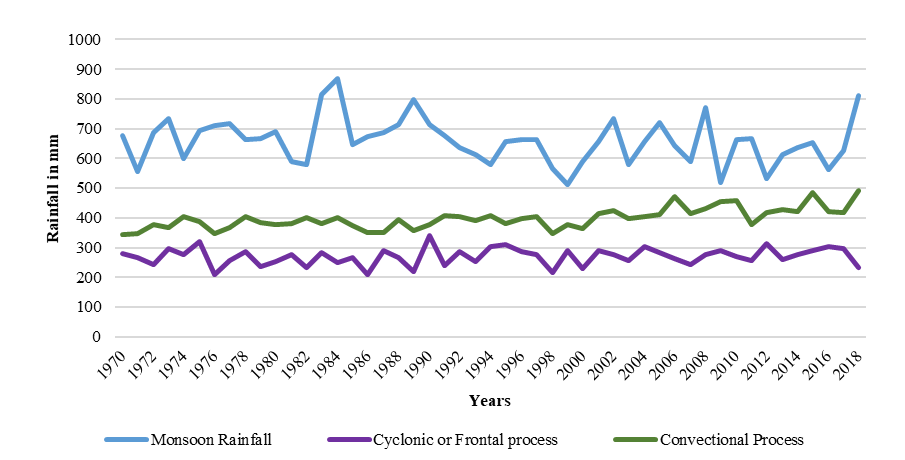
The Northern province of Sri Lanka generally receives its total rainfall from various processes such as monsoon process, cyclonic or frontal process (North-East Monsoon rainfall), convectional process, and the expansion of Inter-Tropical Convergence Zone (ITCZ). The Monsoon process is the leading contributor to the rainfall of the Northern province of Sri Lanka, and it is the response for 65% of the total rainfall. However, the convectional process is playing a critical role in determining the amount of rainfall and the rainy days' amount during the summer months in the study area, especially during the recent past two decades. The convectional process is producing unstable and unpredictable weather conditions giving rise to unexpected rainfall.
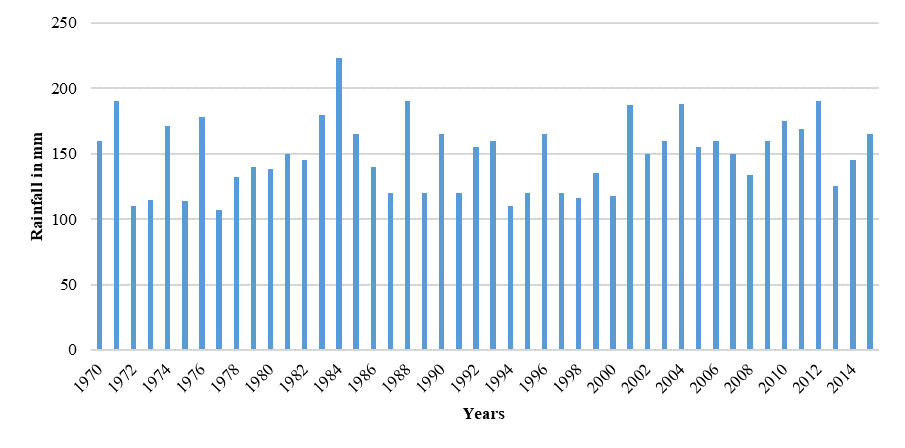
In the Northern province of Sri Lanka, the convectional process generally occurs in the evening and early morning during March, April, May, August, and September. During this period, the position of the sun is almost overhead in the study area (At the latitudes near to Sri Lanka). As a result, convectional currents have been created during noon and massive uplift of water vapour in to the lower part of the troposphere and cooling by the atmosphere and rainfall occur between 3.30 P.M. and 6.45 P.M. and 430.A.M. and 8.00 A.M. This convectional process contributes rainfall to the study area during the peak water scarcity season and helps to recharge the surface and groundwater.
Consequently, this rainfall is vital to the northern province. The average rainfall of the convectional process is more than 330 mm (it is equal to 38% of total rainfall) in the Northern Province. Compared with the past climatic period 1940-1970, this decade has seen an increasing influence on the pattern of convectional rainfall by 40%, with some spatial variations in this percentage also identified. Figure
Compare to other years, some of the years, such as 1976, 1984,1985, 1989, and 1999 received 40% more rainfall than average convectional rainfall, and 1977, 1988, and 1998 received 40% lower rainfall than the average in the Northern Province (figure
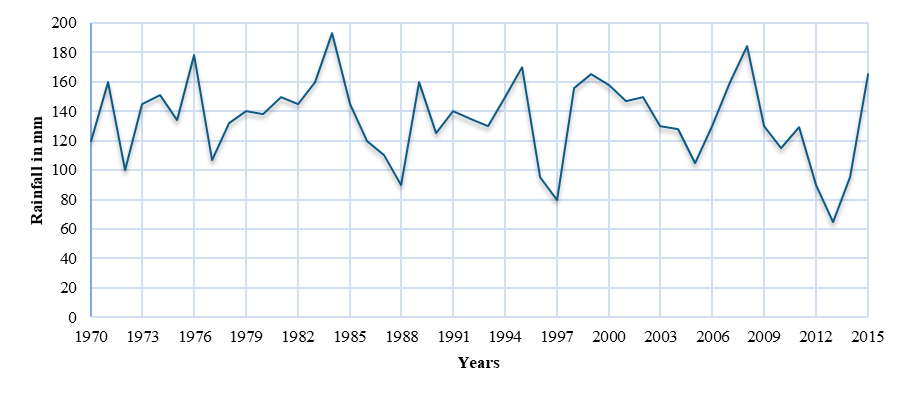
During the FIMS, the study area receiving a certain amount of rainfall due to the convectional process, especially during the April study area receiving more than 75mm average. Figure
Spatially study area receiving the various amount of rainfall. Compare to other convectional months, May receiving a low amount of rainfall. At the same time, all places of the study area receiving the highest amount of rainfall during the October figure
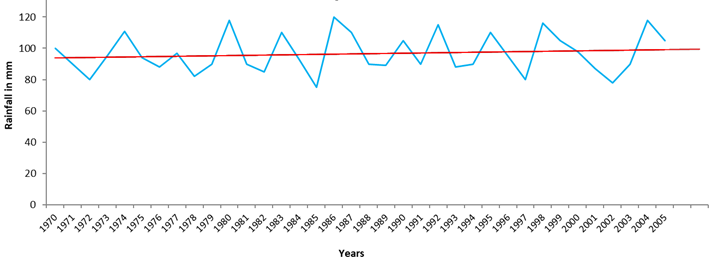
The month of October generally receives more than 45% of the total convectional rainfall, compared to all other months (Figure
However, an uncertainty situation also prevails during the convectional rainfall. Many fluctuations have been identified in this rainfall type. Compared with other periods, the latter part of March and the middle part of April in the First Inter Monsoon Season (Figure
Convectional rainfall is the significant rainfall in the province because it is occurring during the two dry seasons of the first inter monsoon season and the later part of the southwest monsoon seasons. These two seasons are identified as drought seasons, with most of the areas of the province facing severe drought vulnerability. Some of the regions, especially Manthai West, Madhu, Poonkari, Island south, Island North, Karainagar, and Delft divisional secretariat divisions, are faced with extreme difficulties in getting drinking water. So, the occurrence of rainfall in these seasons is considered as a “savior” to the people. This convectional rainfall is the primary source for the recharge to the groundwater in the Jaffna district as well as the mainland of the Northern Province.
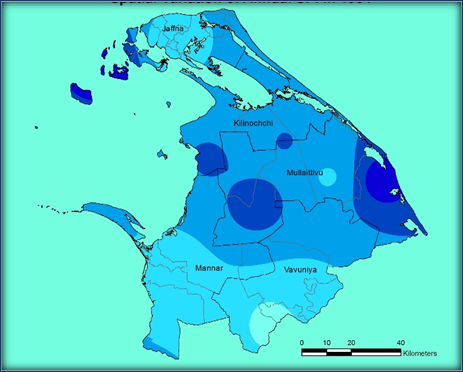
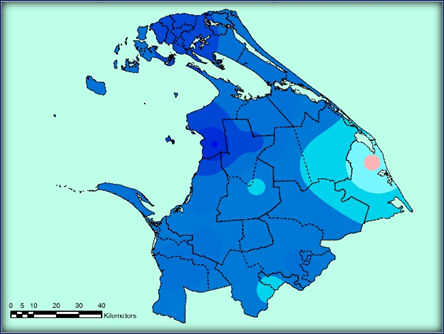
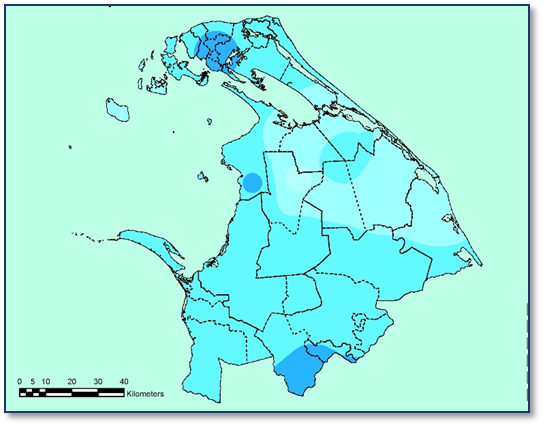
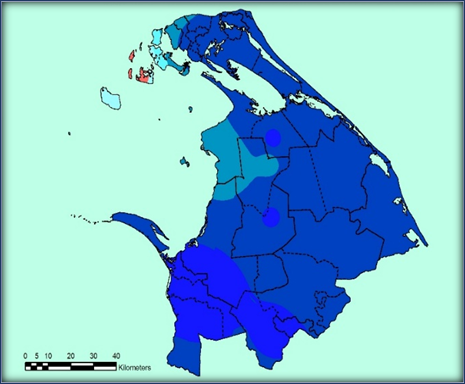
High temperature during the Convectional Period
Analysis results show that the average monthly temperature in the Northern Sri Lanka for the convectional months is higher than during the other months. Also, the hottest month of the study area falls under the convectional period. July identified as the hottest month of the year in the Northern region, but the convectional process is the main reason for the highest temperature in July. However, spatially, all places of the Northern province have the highest monthly rainfall during the convectional periods. Spatially there some variations in the temperature between the places and the However, coastal areas have low temperatures compared to other places due to the changes in the evaporation rate in the coastal parts of the study area.
Generally, we can see the variations in the temperature range between the day and night temperatures in the Northern province of Sri Lanka, which creates severe weather variations between day and night. The relative humidity changes rapidly between day and night and it is indicated in Figure
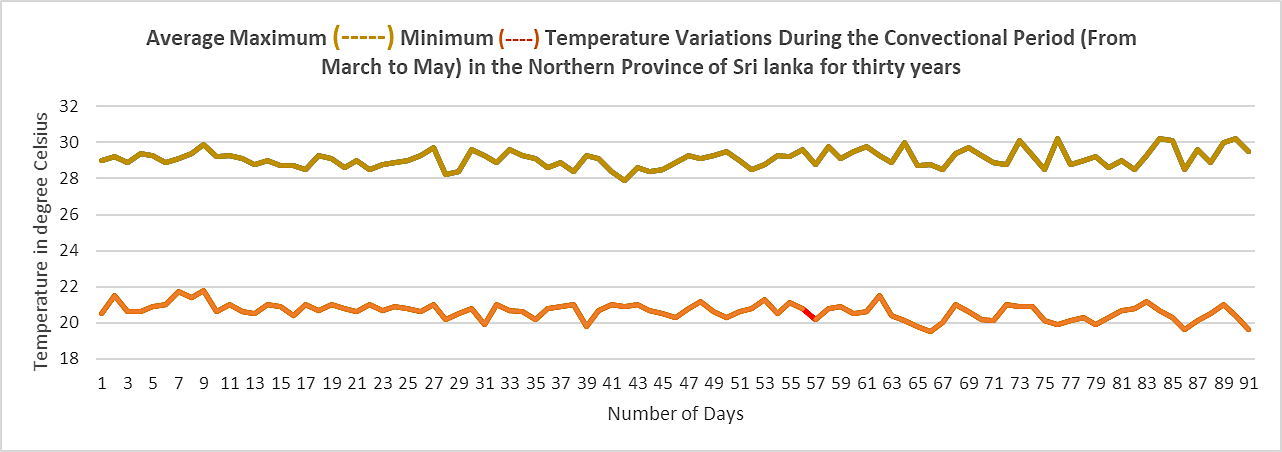
Unstable Relative humidity
Convection creates unstable relative humidity in the Northern province of Sri Lanka during the convection months. Mostly relative humidity is higher than the average. The relative humidity of the research area is averagely 72%, but the values are generally much higher than this during many days of the convection months. The average humidity in the convectional months is 80.15%, but it varies from day to day and place to place. There are vast variations between the day and night time relative humidity. About 83% of the people of the study area expressed that a high percentage of the relative humidity in the night time is the primary reason for the uncomfortable weather situation in the night time in the study area. A vast mass of water evaporation and water vapor are the primary causes of this high rate of relative humidity.
Severe thunder and lightning events
Data from this study shows that the convectional process in the research area is inducing an increasing rate of thunder and lightning events in the study area. Figure
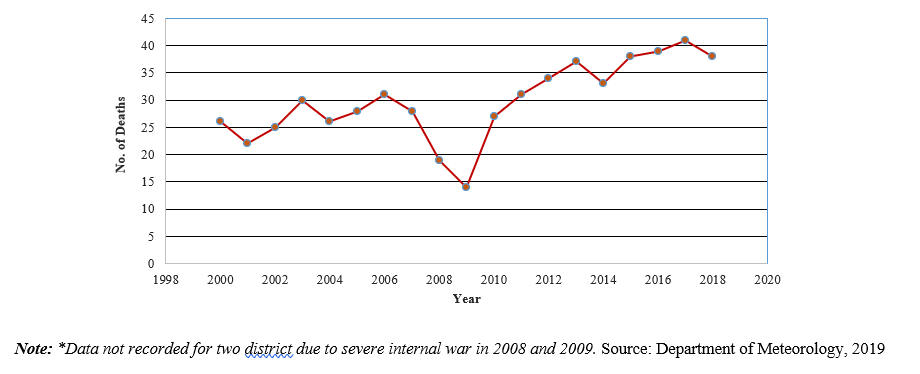
Conclusion
This study shows that the convectional process has much influence on the weather pattern of the Northern part of Sri Lanka, especially rainfall, and this is contributing to the livelihood and survival of people of the Northern part of Sri Lanka. The percentage of this convectional rainfall in annual total rainfall has increased in the area. There is an increasing pattern that has been identified, and not only that, the convectional rainfall for October also increasing, and the analysis reveals that increasing. Convectional rainfall is the crucial factor which is contributing to recharge the surface and groundwater resources of the study area, two principal sources of water for human society. Compared with the monsoon rainfall and the frontal rainfall, the role played by the convectional rainfall in modifying the weather has an enormous contribution to the sustainable development of the study area. Most importantly, the results showed that the convection process generates a significant amount of rainfall during the extended water scarcity months. Convection is shown to contribute more than 30% of the total rainfall in the Northern Province of Sri Lanka. There are some fluctuations in the temperature and relative humidity for the convectional months; however, there some variations have been identified in the durational range of temperature and humidity. The number of deaths due to thunder and lightning event is increasing in the study area. However, convection can also contribute to the occurrence of severe thunder and lightning, and this causes a certain number of deaths. However, if we adopt the protection and safety methods during the current period, we can reduce the deaths due to severe thunder and lightning events. At the same time, convection is the main reason for the high temperatures in the study area during March, April, May, September, and October. Convection is also shown to contribute to the high evaporation and humidity rates.
Hence, data for the years of 2008 and 2009 are collected only three districts out of five districts due to severe internal war held in the study area. Future climatological research in Sri Lanka should focus on the influence on convection as an important influencing factor on its climate. In conclusion, the Convectional process taking the leading role in determining the weather pattern of the study area. However, it is clear that the convectional process not only affects the weather pattern but also contributes to sustaining the human habitation in the northern province of Sri Lanka.
Acknowledgments
Researchers would like to thank the School of Humanities (PPIK), University Sains Malaysia (USM), for the funding aid for publishing this research paper.
References
- Amali, M. (2019), April 17. Lightning kills three. Daily News. http://www.dailynews.lk/2019/04/17/ local/183192/lightning-kills-three
- Chan, N. W., Tan, M. L., Ghani, A. A., & Zakaria, N. A. (2019). Sustainable urban drainage as a viable measure of coping with heat and floods due to climate change. In IOP Conference Series: Earth and Environmental Science (Vol. 257, No. 1, p. 012013). IOP Publishing.
- Gilbert, R. O. (1987). Statistical Methods for Environmental Pollution Monitoring, Van no Stan Reinhold Company. New York.
- Lal, D. S. (2005). Climatology. New Delhi. Chaitanya Publication. New Delhi. India.
- Kendall, M. G. (1975). Rank Correlation Methods. Charles Griffin. London
- Kumar, N., Panchal, C. C., Chandrawanshi, S. K., & Thanki, J. D. (2017). Analysis of rainfall by using Mann-Kendall trend, Sen’s slope and variability at five districts of south Gujarat, India. Mausam, 68(2), 205-222.
- Othman, M. A., Zakaria, N. A., Ghani, A. A., Chang, C. K., & Chan, N. W. (2016). Analysis of trends of extreme rainfall events using Mann Kendall test: a case study in Pahang and Kelantan river basins. Journal Technology, 78(6), 92-99.
- Piratheeparajah, N. (2015). Spatial and Temporal Variations of Rainfall in the Northern Province of Sri Lanka. Journal of Environmental and Earth Science, 5(15), 179-189.
- Rajendram, K. (2004). Rainfall Variability, Drought and El Nino Southern Oscillation over dry zone Sri Lanka. Leonard Woolf Memorial International Conference (pp. 65-78). Matara: University of Ruhuna, Matara. Sri Lanka
- Thampaiyapillai, G. (1958). Rainfall Fluctuation in Ceylon. Ceylon Geographer, 05(02), 12-34.
Copyright information

This work is licensed under a Creative Commons Attribution-NonCommercial-NoDerivatives 4.0 International License.
About this article
Publication Date
12 October 2020
Article Doi
eBook ISBN
978-1-80296-088-4
Publisher
European Publisher
Volume
89
Print ISBN (optional)
-
Edition Number
1st Edition
Pages
1-796
Subjects
Business, innovation, sustainability, environment, green business, environmental issues, urban planning, municipal planning, disasters, social impact of disasters
Cite this article as:
Nagamuthu, P., & Weng, C. N. (2020). Convectional Influences on The Weather Pattern of Northern Sri Lanka. In N. Samat, J. Sulong, M. Pourya Asl, P. Keikhosrokiani, Y. Azam, & S. T. K. Leng (Eds.), Innovation and Transformation in Humanities for a Sustainable Tomorrow, vol 89. European Proceedings of Social and Behavioural Sciences (pp. 477-487). European Publisher. https://doi.org/10.15405/epsbs.2020.10.02.43

